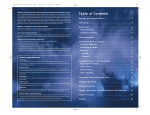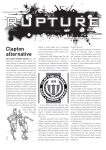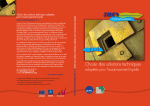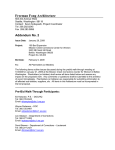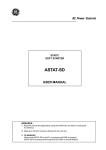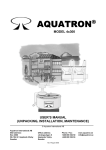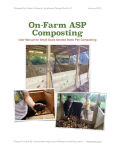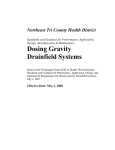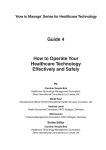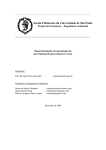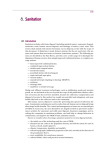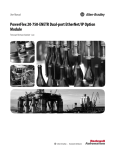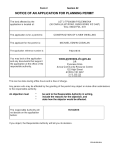Download Compendium of Sanitation Systems and Technologies
Transcript
Collection and Storage/Treatment 49 Eawag-Sandec – Sanitation Systems Functional Group S: Collection and Storage/Treatment This section describes the technologies that collect and store the intermediate products that are generated at the User Interface. Some of the technologies presented herein are designed specifically for treatment, while others are designed specifically for collection and storage, although they provide some degree of treatment depending on the storage time. S 50 Eawag-Sandec – Sanitation Systems Functional Group S: Collection and Storage/Treatment S S.1 Application Level Household Neighbourhood City Management Level Household Shared Public Eawag-Sandec – Sanitation Systems Functional Group S: Collection and Storage/Treatment When urine cannot be used immediately or transported using a Conveyance Technology (i.e. Jerrycans) it can be stored onsite in containers or tanks. The Storage Tank must then be moved or emptied into another container for transport. 51 Applicable to: System 4, 8 Urine Storage Tank/Container The Storage Tank should be appropriately sized to accommodate the number of users and the time required to sanitise the urine. The storage guidelines for urine correspond to the temperature of storage and the intended crop, but all urine should be stored for at least 1 month (see WHO guidelines for specific storage and application guidelines). Smaller volume Storage Tanks can be used and transported to another, centralized Storage Tank at, or close to, the point of use (i.e. the farm). Mobile Storage Tanks should be plastic or fibreglass, but permanent Storage Tanks can be made of concrete or plastic. Metal should be avoided as it can be easily corroded by the high pH of stored urine. With storage time, a layer of organic sludge and precipitated minerals (primarily calcium and magnesium phosphates) will form on the bottom of the tank. Any tank used for urine storage should have an Inputs: Outputs: Urine Stored Urine opening large enough so that it can be cleaned and/ or pumped out. Neither the Storage Tank, nor the collection pipes should be ventilated, but they both need to be pressure equalized. If the Storage Tank is emptied using a vacuum truck, the inflow of air must be maintained at a sufficient rate to ensure that the tank does not implode due to the vacuum. If the Storage Tank is connected to the toilet or urinal directly with a pipe, care should be taken to minimize the length of the pipe since precipitates will accumulate. If pipes must be used, they should have a steep slope (greater than 1% slope), no sharp angles, large diameters (up to 110mm for underground pipes) and be easily removable in case of blockages. To minimize odours, the tank should be filled from the bottom, i.e. the urine should flow down through a pipe and be released near the bottom of the tank; this will prevent the urine from spraying as well as prevent back-flow. Adequacy Long-term storage is the best way to sanitize urine without the addition of chemicals or mechanical processes. S.1 S.1 Urine Storage Tanks can be used in virtually every environment; tanks should be well-sealed to prevent leaks, infiltration and evaporation. Urine Storage Tanks can be installed indoors, outdoors, above ground and below ground depending on the climate, space available, and soil. Pros & Cons: + Can be built and repaired with locally available materials + No electrical energy required + Can be used immediately + Small land area required + Low capital and operating costs - Mild to strong odour when opening and emptying tank (depending on storage conditions) References _ GTZ (2007). Technical data sheet, urine diversion: Piping and storage. GTZ, Germany. Available: www.gtz.de _ Kvarnström, E., et al. (2006). Urine Diversion - One step towards sustainable sanitation. Report 2006-1. Ecosan Res: Ecosan Publication Series, Stockholm. Available: www.ecosanres.org _ WHO (2006). Guidelines for the safe use of wastewater, excreta and greywater- Volume 4: Excreta and greywater use in agriculture. WHO, Geneva. Available: www.who.int 52 Maintenance A viscous sludge will accumulate on the bottom of the Storage Tank. When the Storage Tank is emptied, the sludge will usually be emptied along with the urine, but if a tap is used and the tank is never fully emptied, it may require desludging. The desludging period will depend on the composition of the urine and the storage conditions. Mineral and salt build-up in the tank or on connecting pipes can be manually removed (sometimes with difficulty) or can be dissolved with a strong acid (24% acetic). Eawag-Sandec – Sanitation Systems Functional Group S: Collection and Storage/Treatment Health Aspects/Acceptance The risk of disease transmission from stored urine is low. Extended storage with storage times greater than 6 months provides near complete sanitation. S.2 Applicable to: System 1 Single Pit Management Level Household Shared Public Inputs: Excreta Anal Cleansing Water Faeces Outputs: Faecal Sludge Excreta support ring > 3m 20-40cm Application Level Household Neighbourhood City 53 Eawag-Sandec – Sanitation Systems Functional Group S: Collection and Storage/Treatment The Single Pit is one of the most widely used sanitation technologies. Excreta, along with anal cleansing materials (water or solids) are deposited into a pit. Lining the pit prevents it from collapsing and provides support to the superstructure. As the Single Pit fills, two processes limit the rate of accumulation: leaching and degradation. Urine and anal cleansing water percolate into the soil through the bottom of the pit and wall while microbial action degrades part of the organic fraction. On average, solids accumulate at a rate of 40 to 60L per person/year and up to 90L per person/year if dry cleansing materials such as leaves, newspapers, and toilet paper are used. The volume of the pit should be designed to contain at least 1,000L. Ideally the pit should be designed to be at least 3m deep and 1 m in diameter. If the pit diameter exceeds 1.5m there is an increased risk of collapse. Depending on how deep they are dug, some pits may last up to 20 years without emptying. If the pit is to be reused it should be lined. Pit lining materials can include brick, rot-resistant timber, concrete, stones, or mortar plastered onto the soil. If the soil is stable (i.e. no presence of sand or gravel de- posits or loose organic materials), the whole pit need not be lined. The bottom of the pit should remain unlined to allow the infiltration of liquids out of the pit. As the effluent leaches from the Single Pit and migrates through the unsaturated soil matrix, faecal organisms are removed. The degree of faecal organism removal varies with soil type, distance travelled, moisture and other environmental factors and thus, it is difficult to estimate the necessary distance between a pit and a water source. A distance of 30m between the pit and a water source is recommended to limit exposure to chemical and biological contamination. When it is impossible or difficult to dig a deep pit, the depth of the pit can be extending by building the pit upwards with the use of concrete rings or blocks. This adaptation is sometimes referred to as a cesspit. It is a raised shaft on top of a shallow pit with an open bottom that allows for the collection of faecal sludge and the leaching of effluent. This design however, is prone to improper emptying since it may be easier to break or remove the concrete rings and allow the faecal sludge to flow out rather than have it emptied and disposed of properly. S.2 S.2 Health Aspects/Acceptance A simple Single Pit is an improvement to open defecation; however, it still poses health risks: • Leachate can contaminate groundwater; • Stagnant water in pits may promote insect breeding; • Pits are susceptible to failure/overflowing during floods. Single Pits should be constructed at an appropriate distance from homes to minimize fly and odour nuisances and to ensure convenience and safe travel. Upgrading A Ventilated Improved Pit (VIP) is slightly more expensive but greatly reduces the nuisance of flies and odours, while increasing comfort and usability. For more information on the VIP please refer to S3: Single Pit VIP Technology Information Sheet. When two pits are dug side-by-side, one can be used while the contents of the other pit are allowed to mature for safer emptying. For more information on dual pit technologies refer to S4: Double Pit VIP and S6: Twin Pits for Pour Flush Technology Information Sheets. Pros & Cons: + Can be built and repaired with locally available materials + Does not require a constant source of water + Can be used immediately after construction + Low (but variable) capital costs depending on materials - Flies and odours are normally noticeable - Sludge requires secondary treatment and/or appropriate discharge - Costs to empty may be significant compared to capital costs - Low reduction in BOD and pathogens References _ Brandberg, B. (1997). Latrine Building. A Handbook for Implementation of the Sanplat System. Intermediate Technology Publications, London. (A good summary of common construction problems and how to avoid mistakes.) _ Franceys, R., Pickford, J. and Reed, R. (1992). A guide to the development of on-site sanitation. WHO, Geneva. (For information on accumulation rates, infiltration rates, general construction and example design calculations.) _ Lewis, J W., et al. (1982). The Risk of Groundwater Pollution by on-site Sanitation in Developing Countries. International Reference Centre for Waste Disposal, Dübendorf, Switzerland. (Detailed study regarding the transport and die-off of microorganisms and implications for locating technologies.) _ Morgan, P. (2007). Toilets That Make Compost: Low-cost, sanitary toilets that produce valuable compost for crops in an African context. Stockholm Environment Institute, Sweden. (Describes how to build a support ring/foundation.) _ Pickford, J. (1995). Low Cost Sanitation. A Survey of Practical Experience. Intermediate Technology Publications, London. (Information on how to calculate pit size and technology life.) Eawag-Sandec – Sanitation Systems Functional Group S: Collection and Storage/Treatment Adequacy Treatment processes in the Single Pit (aerobic, anaerobic, dehydration, composting or otherwise) are limited and therefore, pathogen reduction and organic degradation is not significant. However, since the excreta are contained, pathogen transmission to the user is limited. Single Pits are appropriate for rural and peri-urban areas; Single Pits in urban or dense areas are often difficult to empty and/or have sufficient space for infiltration. Single Pits are especially appropriate when water is scarce and where there is a low groundwater table. They are not suited for rocky or compacted soils (that are difficult to dig) or for areas that flood frequently. Maintenance There is no daily maintenance associated with a simple Single Pit. However, when the pit is full it can be a) pumped out and reused or b) the superstructure and squatting plate can be moved to a new pit and the previous pit covered and decommissioned. 54 Another variation is the unlined shallow pit that may be appropriate for areas where digging is difficult. When the shallow pit is full, it can be covered with leaves and soil and a small tree can be planted. This concept is called the Arborloo and is a successful way of avoiding costly emptying, while containing excreta, and reforesting an area. The Arborloo is discussed in more detail on the D1: Fill and Cover/Arborloo Technology Information Sheet. S.3 Applicable to: System 1 Single Ventilated Improved Pit (VIP) Management Level Household Shared Public Application Level Household Neighbourhood City Inputs: Excreta Anal Cleansing Water Outputs: Faeces Faecal Sludge > 30cm fly screen >11cm vent pipe 55 Eawag-Sandec – Sanitation Systems Functional Group S: Collection and Storage/Treatment air currents The Single VIP is a Ventilated, Improved Pit. It is an improvement over the Single Pit because continuous airflow through the ventilation pipe vents odours and acts as a trap for flies as they escape towards the light. Despite their simplicity, well-designed Single VIPs can be completely smell free, and be more pleasant to use than some other water-based technologies. Flies that hatch in the pit are attracted to the light at the top of the ventilation pipe. When they fly towards the light and try to escape they are trapped by the fly-screen and die. The ventilation also allows odours to escape and minimizes the attraction for flies. The vent pipe should have an internal diameter of at least 110mm to a maximum of 150mm and reach more than 300mm above the highest point of the toilet superstructure. The vent works better in windy areas but where there is little wind, its effectiveness can be improved by painting the pipe black; the heat difference between the pit (cool) and the vent (warm) creates an updraft that pulls the air and odours up and out of the pit. To test the efficacy of the ventilation, a small, smoky fire can be lit in the pit; the smoke should be pulled up and out of the vent pipe and not remain in the pit or the superstructure. The mesh size of the fly screen must be large enough to prevent clogging with dust and allow air to circulate freely. Aluminium screens, with a hole-size of 1.2 to 1.5mm have proven to be the most effective. The top diameter of the Single VIP should be between 1 to 1.5m and be dug at least 3m deep, although the deeper the better. Deep pits can last up to 15, 20, 30 or more years. As the effluent leaches from the Single VIP and migrates through unsaturated soils, faecal organisms are removed. The degree of faecal organism removal varies with soil type, distance travelled, moisture and other environmental factors and thus, it is difficult to estimate the necessary distance between a pit and a water source. A minimum distance of 30m between the pit and a water source is recommended to limit exposure to chemical and biological contamination. Adequacy Treatment processes in the Single VIP (aerobic, anaerobic, dehydration, composting or otherwise) are limited, and therefore, pathogen reduction and organic degradation is not significant. However, since the excreta are contained, pathogen transmission to the user is limited. This technology is a significant improvement over Single Pits or open defecation. S.3 S.3 Single VIPs are appropriate for rural and peri-urban areas; single pits in urban or dense areas are often difficult to empty and/or have insufficient space for infiltration. Depending on the pit depth, depth to the water table, number of users and soil conditions, some pits can be used for 20 years without emptying. VIPs are especially appropriate when water is scarce and where there is a low groundwater table. They should be located in an area with a good breeze. They are not suited for rocky or compacted soils (that are difficult to dig) or for areas that flood frequently. + Can be built and repaired with locally available materials + Can be used immediately after construction + Low (but variable) capital costs depending on materials and pit depth + Small land area required - Sludge requires secondary treatment and/or appropriate discharge - Costs to empty may be significant compared to capital costs - Low reduction in BOD and pathogens Health Aspects/Acceptance A Single VIP can be a very clean, comfortable, and well accepted sanitation option. However some health concerns exist: • Latrine leachate can contami¬nate groundwater; • Pits are susceptible to failure/overflowing during floods; • Health risks from flies are not completely removed by ventilation. References Pros & Cons: + Flies and odours are significantly reduced (compared to non-ventilated pits) + Does not require a constant source of water + Suitable for all types of user (sitters, squatters, washers and wipers) _ Morgan, P R. (1977). The Pit Latrine – Revived. Central African Journal of Medicine, 23(1). _ Morgan, P R. (1979). A Ventilated Pit Privy. Appropriate Technology, 6 (3). _ Morgan P R. and Mara, D D. (1982). Ventilated Improved Pit Latrines: Recent Developments in Zimbabwe. World Bank Technical Paper no.3. Available: www.worldbank.org _ Morgan P R. (1990). Rural Water Supplies and Sanitation. Blair Research Laboratory & Ministry of Health + MacMillan, Harare, Zimbabwe. General Information: _ Franceys, R., Pickford, J. and Reed, R. (1992). A guide to the development of on-site sanitation. WHO, Geneva. _ Lewis, J W., et al. (1982). The Risk of Groundwater Pollution by on-site Sanitation in Developing Countries. International Reference Centre for Waste Disposal, Dübendorf, Switzerland. (A detailed study regarding the transport and die-off of microorganisms and implications for locating technologies.) _ The World Bank (1986). Information and Training for Low-Cost Water Supply and Sanitation (UNDP Project INT/82/002). The World Bank, Washington. Eawag-Sandec – Sanitation Systems Functional Group S: Collection and Storage/Treatment Maintenance To keep the Single VIP free of flies and odours, regular cleaning and maintenance is required. Dead flies, spider webs, dust and other debris should be removed from the ventilation screen to ensure a good flow of air. _ Mara D D. (1984). The Design of Ventilated Improved Pit Latrines (UNDP Interreg. Project INT/81/047). The World Bank + UNDP, Washington. 56 Upgrading A Single VIP toilet can be upgraded to a Double VIP, a Urine Diverting Dry Toilet (UDDT) if there is a use for urine, or a water-based Pour Flush Toilet if water is available. A Double VIP has the addition of an extra pit so that while one pit is in use, the contents of the full pit are draining, maturing and undergoing degradation. Pathogens are destroyed much more thoroughly in a Double VIP and therefore, the contents are less hazardous to remove from the pit, although because the contents are so solid, the contents cannot be pumped, but rather, must be manually emptied. _ Mara, D D. (1996). Low-Cost Urban Sanitation. Wiley, Chichester, UK. (Provides detailed design information.) S.4 Double Ventilated Improved Pit (VIP) Application Level Household Neighbourhood City Management Level Household Shared Public Inputs: Excreta Anal Cleansing Water Outputs: fly screen Faeces Compost/EcoHumus fly screen >11cm vent pipe 1 Applicable to: System 2 >11cm vent pipe 2 air currents air currents sludge sludge sludge 57 Eawag-Sandec – Sanitation Systems Functional Group S: Collection and Storage/Treatment The Double VIP has almost the same design as the Single VIP (S3) with the added advantage of a second pit that allows the technology to be used continuously and allows for safer and easier emptying. By using two pits, one pit can be used while the contents of the second pit rests, drains, reduces in volume, and degrades. When the second pit is almost full (the excreta is 50cm from the top of the pit), it is covered, and the contents of the first pit are removed. Due to the extended resting time (at least 1 year of filling/resting) the material within the pit should be sanitized and humus-like. The Double VIP is similar to the Fossa Alterna (S5) technology with the exception that the Fossa Alterna is specifically designed to produce humus and as such, it requires regular additions of soil, ash and/or leaves. The superstructure may either extend over both holes or it may be designed to move from one pit to the other. In either case, the pit that is not being filled should be fully covered and sealed to prevent water, garbage and animals (and/or people) from falling into the pit. The ventilation of the two pits can be accomplished using one ventilation pipe moved back and forth between the pits or each pit can be equipped with its own dedicated pipe. The two pits in the Double VIP are continually used and should be well lined and supported to ensure longevity. Adequacy The Double VIP is more appropriate than the Single VIP for denser, peri-urban areas. The material is manually emptied (it is dug out, not pumped out), so vacuum truck access to the pits is not necessary. The users can remove the pit material after a sufficient resting time of one or more years even though the treatment processes in the pit are not complete and the material is not entirely hygienic. The Double VIP technology will only work properly if the two pits are used sequentially and not concurrently. Therefore, an adequate cover for the out of service pit is required. Double VIPs are especially appropriate when water is scarce and where there is a low groundwater table. They should be located in an area with a good breeze. They are not suited for rocky or compacted soils (that are difficult to dig) or for areas that flood frequently. Health Aspects/Acceptance The Double VIP can be a very clean, comfortable and well accepted sanitation option, in some cases even more so than a water- S.4 S.4 based technology. However some health concerns exist: • Latrine leachate can contaminate groundwater; • Pits are susceptible to failure/overflowing during floods; and • Health risks from flies are not completely removed by ventilation. _ Mara D D. (1984). The Design of Ventilated Improved Pit Latrines (UNDP Interreg. Project INT/81/047). The World Bank+ UNDP, Washington. (A good reference for detailed Double Pit VIP design information.) _ Mara, D D. (1996). Low-Cost Urban Sanitation. Wiley, Chichester, UK. (General description of VIPs with a focus on the ventilation system.) General Information: _ Franceys, R., Pickford, J. and Reed, R. (1992). A guide to the development of on-site sanitation. WHO, Geneva. _ Lewis, J W., et al. (1982). The Risk of Groundwater Pollution by on-site Sanitation in Developing Countries. International Reference Centre for Waste Disposal, Dübendorf, Switzerland. (Detailed study regarding the transport and die-off of microorganisms and implications for locating technologies.) _ The World Bank (1986). Information and Training for Low-Cost Water Supply and Sanitation (UNDP Project INT/82/002). The World Bank, Washington. Eawag-Sandec – Sanitation Systems Functional Group S: Collection and Storage/Treatment Pros & Cons: + Longer life than Single VIP (indefinite if maintained) + Potential for use of stored faecal material as soil conditioner + Flies and odours are significantly reduced (compared to non-ventilated pits) + Does not require a constant source of water + Suitable for all types of user (sitters, squatters, washers and wipers) + Can be built and repaired with locally available materials + Can be used immediately after construction + Small land area required - Low/moderate reduction in pathogens - Higher capital cost than Single VIP; reduced operating costs if self-emptied References 58 Maintenance To keep the Double VIP free of flies and odours, regular cleaning and maintenance is required. Dead flies, spider webs, dust and other debris should be removed from the ventilation screen to ensure a good flow of air. The out of service pit should be well sealed to reduce water infiltration and a proper alternating schedule must be maintained. S.5 Application Level Household Neighbourhood City 1 Applicable to: System 2 Fossa Alterna Management Level Household Shared Public 2 59 Eawag-Sandec – Sanitation Systems Functional Group S: Collection and Storage/Treatment The Fossa Alterna is an alternating, waterless (dry) double pit technology. Compared to the Double VIP which is just designed to collect, store and partially treat excreta, the Fossa Alterna is designed to make EcoHumus. The Fossa Alterna is dug to a maximum depth of 1.5 m and requires a constant input of soil. One of the Fossa Alterna pits should fill over a period of 12–24 months depending on the size of the pit and the number of users. The full pit degrades during the period of time that the second pit is filling, which, ideally, should take one year. The material in the full pit will degrade into a dry, earth-like mixture that can be easily removed manually. Soil, ash, and/or leaves should be added to the pit after defecation (not urination). The soil and leaves introduce a variety of organisms like worms, fungi and bacteria which help in the degradation process. Also, the pore space is increased, which allows for anaerobic conditions. Additionally, the ash helps to control flies, reduce odours and make the mix slightly more alkaline. The Fossa Alterna should be used for urine, but water should not be added (small amounts of anal cleansing water can be tolerated). Water encourages the develop- Inputs: Excreta Anal Cleansing Water Outputs: Organics Compost/EcoHumus 3 ment of vectors and pathogens but it also fills the porespaces and deprives the aerobic bacteria of the oxygen that is required for degradation. The choice of User Interface will determine the material that enters the pit. Since bulking material is used to continuously cover the excreta, smells are reduced but the addition of a ventilation pipe can reduce the smells even further. The Fossa Alterna pits are relatively shallow with a depth of 1.5 m. Even though the pits are shallow, this should be more than enough space to accommodate a family of 6 for one year. To optimize the space, the material that mounds in the centre of the pit (underneath the toilet) should be pushed to the sides periodically. Unlike a simple or ventilated pit which will be covered or emptied, the material in the Fossa Alterna is meant to be reused. Therefore, it is extremely important that no garbage is put into the pit as it will reduce the quality of the material recovered, and may even make it unusable. Emptying the Fossa Alterna is easier than emptying other pits: the pits are shallower and the addition of soil means that the material is less compact. The material that is removed is not offensive and presents a reduced threat of contamination. S.5 S.5 Maintenance When the first pit is put into use, a layer of leaves should be put into the bottom of the pit. Pros & Cons: + Can be built and repaired with locally available materials + Because double pits are used alternately, their life is virtually unlimited + Excavation of humus is easier than faecal sludge + Potential for use of stored faecal material as soil conditioner + Flies and odours are significantly reduced (compared to non-ventilated pits) + Does not require a constant source of water + Suitable for all types of user (sitters, squatters, washers and wipers) + Low (but variable) capital costs depending on materials; no or low operating costs if self-emptied + Small land area required + Significant reduction in pathogens - Requires constant source of cover material (soil, ash, leaves, etc.) - Garbage may ruin reuse opportunities of Compost/EcoHumus References _ Morgan, P. (2007) Toilets That Make Compost: Low-cost, sanitary toilets that produce valuable compost for crops in an African context. Stockholm Environment Institute, Sweden. Available: www.ecosanres.org (Step-by-step guide for building a Fossa Alterna.) Eawag-Sandec – Sanitation Systems Functional Group S: Collection and Storage/Treatment Health Aspects/Acceptance By covering faeces with soil/ash, flies and odours are kept to a minimum. Users may not understand the difference between the Fossa Alterna and a Double VIP, although if given the opportunity to use one, people should have a good appreciation of the advantages. Demonstration units can be used to show how easily one can empty a Fossa Alterna in comparison to emptying a Double Pit. Keeping the contents sealed in the pit for the duration of at least one year makes the material safer and easy to handle. The same precautions that are taken when handling compost should be taken with the humus derived from the Fossa Alterna. Periodically, more leaves should be added to increase the porosity and oxygen availability. Following the addition of faeces to the pit, a small amount of soil or ash should be added. To lengthen the filling time of the pit soil is not added to the pit following urination. Occasionally, the mounded material beneath the toilet hole should be pushed to the sides of the pit for an even distribution of materials. Depending on the dimensions of the pits, materials should be emptied every year. 60 Adequacy The Fossa Alterna is appropriate for rural and peri-urban areas. It is especially adapted to waterscarce environments. It is a useful solution for areas that have poor soil and could benefit from the composted humic material as a soil amendment. A constant source of soil, ash and/or leaves is required. The Fossa Alterna is not appropriate for greywater as the pit is shallow and the conditions must remain aerobic for degradation. Another greywater treatment system must be used in parallel. A UDDT can be used with the Fossa Alterna, but only in circumstances when the soil cannot sufficiently absorb the urine or when urine is highly valued for application. The material is manually emptied from the Fossa Alterna (it is dug out, not pumped out), so vacuum truck access to the pits is not necessary. The Fossa Alterna technology will only work properly if the two pits are used sequentially and not concurrently. Therefore, an adequate cover for the out of service pit is required. The Fossa Alterna is especially appropriate when water is scarce. It is not suited for rocky or compacted soils (that are difficult to dig) or for areas that flood frequently. S.6 Applicable to: System 3 Twin Pits for Pour Flush Application Level Household Neighbourhood City Management Level Household Shared Public Inputs: Blackwater Anal Cleansing Water Outputs: Greywater Compost/EcoHumus leach pit leach pit 61 Eawag-Sandec – Sanitation Systems Functional Group S: Collection and Storage/Treatment This technology consists of two alternating pits connected to a Pour Flush Toilet. The blackwater (and greywater) is collected in the pits and allowed to slowly infiltrate into the surrounding soil. With time, the solids are sufficiently dewatered and can be manually removed with a shovel. The superstructure, toilet and pits, for the Twin Pits with Pour Flush technology can be designed in various ways: the toilet can be located directly over the pits or at a distance from the pits. The superstructure can be permanently constructed over both pits or it can move from side to side depending on which pit is in use. No matter how the system is designed, only one pit is used at a time. In this way, a continuous cycle of alternating pits means that they can be used indefinitely. While one pit is filling with excreta, cleansing water and flushing water, the other full pit is resting. The pits should be an adequate size to accommodate a volume of waste generated over one or two years. This allows the contents of the full pit enough time to transform into a safe, inoffensive, soil-like material that can be excavated manually. The difference between this technology and the Double VIP or Fossa Alterna is that it allows for the addition of water and does not include the addition of soil or organic material. As this is a water-based (wet) technology, the full pits require a longer retention time to degrade the material before is can be excavated safely. A retention time of 2 years is recommended. The degraded material is too solid to be removed with a vacuum truck. As the effluent leaches from the pit and migrates through an unsaturated soil matrix, faecal organisms are removed. The degree of faecal organism removal varies with soil type, distance travelled, moisture and other environmental factors. There is a risk of groundwater pollution whenever there is a high or variable water table, fissures and/or cracks in the bedrock. Viruses and bacteria can travel hundreds of metres in saturated conditions. As soil and groundwater properties are often unknown, it is difficult to estimate the necessary distance between a pit and a water source. A minimum distance of 30 m should be maintained between the pit and a water source to limit exposure to chemical and biological contamination. It is recommended that the Twin Pits be constructed 1m apart from each other to minimize cross-contamination between the maturing pit and the one in use. It S.6 S.6 is also recommended that the pits be constructed over 1m from any structural foundation as leachate can negatively impact structural supports. Water within the pit can impact the structural stability of the pit. Therefore, all walls should be lined up to the full depth of the pit to prevent collapse and the top 30cm should be fully mortared to prevent direct infiltration and ensure that the superstructure is supported. Maintenance The pits must be emptied regularly and care must be taken to ensure that they do not flood during rainy seasons. After a recommended two year resting time, the pits should be emptied manually using long handled shovels and proper personal protection. If the pits are self-emptied there are no operational costs except for any replacements to the structure or slab in the event of damage. Adequacy The Twin Pits with Pour Flush is a permanent technology that is appropriate for areas where it is not appropriate to continuously move a pit latrine. It is a water-based technology and is only appropriate where there is a constant supply of water for flushing (e.g. recycled greywater or rainwater). Greywater can be co-managed along with the blackwater in the twin pits. This technology is not appropriate for areas with a high groundwater table or areas that are frequently flooded. In order for the pits to drain properly, the soil must have a good absorptive capacity; clay, tightly packed or rocky soils are not appropriate. As long as water is available, the Twin Pits with Pour Flush technology is appropriate for almost every type of housing density. However, too many wet pits in a small area is not recommended as there may not be sufficient capacity to absorb the liquid into the soil matrix from all of the pits and the ground may become water-logged (oversaturated). The material is manually emptied from the Twin Pits (it is dug out, not pumped out), so vacuum truck access to the pits is not necessary. The Twin Pits with Pour Flush technology will only work properly if the two pits are used sequentially and not concurrently. Therefore, an adequate cover for the out of service pit is required. Pros & Cons + Can be built and repaired with locally available materials + Because double pits are used alternately, their life is virtually unlimited + Excavation of humus is easier than faecal sludge + Potential for use of stored faecal material as soil conditioner + Flies and odours are significantly reduced (compared to pits without a waterseal) + Low (but variable) capital costs depending on materials; no or low operating costs if self-emptied + Moderate reduction in pathogens - Excreta require manual removal - Clogging is frequent when bulky cleansing materials are used _ Roy, A K., et al. (1984). Manual on the Design, Construction and Maintenance of Low-Cost Pour Flush Waterseal Latrines in India. (UNDP Interreg. Project INT/81/047). The World Bank + UNDP, Washington. General Information: _ Franceys, R., Pickford, J. and Reed, R. (1992). A guide to the development of on-site sanitation. WHO, Geneva. _ Mara, D D. (1996). Low-Cost Urban Sanitation. Wiley, Chichester, UK. _ The World Bank (1986). Information and Training for Low-Cost Water Supply and Sanitation. (UNDP Project INT/82/002). The World Bank, Washington. Eawag-Sandec – Sanitation Systems Functional Group S: Collection and Storage/Treatment Detailed Design information: 62 Health Aspects/Acceptance The waterseal provides a high level of comfort and cleanliness, with few odours. It is a commonly accepted sanitation option, however some health concerns exist: • Latrine leachate can contaminate groundwater; • Stagnant water in pits may promote insect breeding; • Pits are susceptible to failure/overflowing during floods. References S.7 Applicable to: System 4 Dehydration Vaults Application Level Household Neighbourhood City Inputs: Management Level Household Shared Public S.7 Faeces Outputs: Dried Faeces >11cm vent urine diversion pipe view A > 30cm fly screen urine tank view A 63 Eawag-Sandec – Sanitation Systems Functional Group S: Collection and Storage/Treatment Dehydration vaults are used to collect, store and dry (dehydrate) faeces. Faeces will only dehydrate when the vaults are watertight to prevent external moisture from entering and when urine and anal cleansing water are diverted away from the vaults. When urine is separated from faeces, the faeces dry quickly. In the absence of moisture, organisms cannot grow and as such, smells are minimized and pathogens are destroyed. Vaults used for drying faeces in the absence of urine have various local names. One of the most common names for this technology is the Vietnamese Double Vaults. A family of 6 will produce 500L of faeces in approximately six months. For design purposes it is recommended to assume that one person will require almost 100L of faeces storage space every six months. The vaults should be slightly oversized to account for airflow, visitors and the non-even distribution of faeces in the chamber. Each vault is sized to accommodate six months of faeces accumulation which in turn, results in a six month drying time in the out-of-service vault. Two alternating vaults allow the faeces to dehydrate in one vault while the other vault fills. When one vault is full section it is sealed with a lid and the UDDT (U2) is moved to the second vault. While the second vault fills up, the faeces in the first vault slowly dry and decrease in volume. When the second vault is full, it is sealed, the dry material from the first vault is removed and the first vault is then put back into service. The vaults must be watertight to keep the faeces as dry as possible. Chambers should be constructed of sealed block or formed concrete to ensure that rainwater, surface run-off, greywater and urine are prevented from entering the vaults. Urine can be collected in a bucket and discharge to the ground (garden) or stored in a tank for future transport and use. A vent is required to help keep the vaults dry and control flies and odours. Adequacy Dehydration Vaults can be installed in almost every setting from rural to dense urban because of the small land area required, the minimal odours and the ease of use. They are especially appropriate for water scarce and rocky areas. In areas that are frequently flooded, Dehydration Vaults are appropriate because they are constructed to be watertight. Furthermore, where there is no plot of land available, the vaults S.7 Upgrading There is a risk however when using single vaults, that the top portion of the faeces will not be fully dried and/or hygienized. Single vaults are not recommended (because of the need to handle fresh faeces) and should, whenever possible be upgraded to a double vault. Maintenance To prevent flies, minimize odours and encourage drying, a small amount of ash, soil, or lime should be used to cover faeces after each use. Care should be taken to ensure that no water or urine gets into the Dehydration Vault. If this happens, extra soil, ash, lime, or sawdust can be added to help absorb the liquid. Because the faeces are not actually degraded (just dried), dry cleansing materials must not be added to the Dehydration Vaults as they will not decompose. Occasionally, the mounded faeces beneath the toilet hole should be pushed to the sides of the pit for an even drying. Where water is used for cleansing, an appropriate User Interface should be installed to divert and collect it separately. To empty the vaults, a shovel, gloves and possibly a face mask (cloth) should be used to limit contact with the dried faeces. References _ (-) Manual del Sanitario Ecologico Seco. Available: www.zoomzap.com (A very comprehensive manual on dry chamber construction including detailed instruction and material lists. In Spanish.) _ GTZ (2005). Urine diverting dry toilets programme dissemination (data sheet). GTZ, Germany. Available: www.gtz.de (General overview of Dehydration Chambers with some dimensioning and materials lists.) _ Winblad, U., and Simpson-Herbert, M. (eds.) (2004). Ecological Sanitation - revised and enlarged edition. SEI, Stockholm, Sweden. (A general description of various designs and adaptations, especially Chapter 3.) _ Women in Europe for a Common Future (2006). Urine diverting Toilets: Principles, Operation and Construction. Available: www.wecf.de (Photos and explanation of how to build a double vault and superstructure.) Eawag-Sandec – Sanitation Systems Functional Group S: Collection and Storage/Treatment Health Aspects/Acceptance Dehydration Vaults can be a clean, comfortable, and easy-to-use technology. When users are well educated and understand how the technology works they may be more willing to accept it as a viable sanitation solution. When the vaults are kept dry, there should be no problems with flies or odours. Faeces from the double vaults should be very dry and relatively safe to handle provided they were continuously covered with material and not allowed to get wet. There is a low health risk for those whom have to empty or change the urine container. Faeces that have been dried for over one year also pose a low health risk. Pros & Cons: + Can be built and repaired with locally available materials + Because double pits are used alternately, their life is virtually unlimited + Good in rocky and/or flooded areas + Excavation of dried faeces is easier than faecal sludge + No real problems with flies or odours if used correctly + Does not require a constant source of water + Suitable for all types of user (sitters, squatters, washers and wipers) + Low (but variable) capital costs depending on materials; no or low operating costs + Small land area required - Requires education and acceptance to be used correctly - Requires constant source of ash, sand or lime - Requires a use/discharge point for urine and faeces - Urine and faeces require manual removal 64 can be installed indoors, which also makes this technology applicable for colder climates (where leaving the house is less desirable). S.8 Applicable to: System 2 Composting Chamber Application Level Household Neighbourhood City Management Level Household Shared Public Inputs: Organics Outputs: Excreta Compost/EcoHumus ventilation fan leachate barrier leachate 65 Eawag-Sandec – Sanitation Systems Functional Group S: Collection and Storage/Treatment Composting refers to the process by which biodegradable components are biologically decomposed under aerobic conditions by microorganisms (mainly bacteria and fungi). A Composting Chamber converts excreta and organics into Compost. Compost is a stable, inoffensive product that can be handled safely and used as a soil conditioner. This technology usually requires four main parts: 1) a reactor (storage chamber); 2) a ventilation unit to provide oxygen and allow gases (CO2, water vapour) to escape; 3) a leachate collection system ; and 4) an access door to remove the mature product. A Composting Chamber can be designed in various configurations and constructed above or below ground. UDDT can be used as a User Interface for specifically designed Composting Chambers. Anal Cleansing Water should not be added to the composting chamber as it could cause anaerobic conditions, foul smells and reduced collection capacity. There are four factors that will ensure the good functioning of the system: a) sufficient air (oxygen), provided by active aeration (pumped air) or passive aeration; b) proper moisture (ideally moisture content should be between 45–70%); c) internal (heap) temperature of 40–50°C (can be controlled with proper chamber dimensioning); and d) a 25:1 carbon to nitrogen ratio (theoretically) which can be adjusted by adding an external source of carbon such as toilet paper, wood chips, and/or vegetable scraps. It is appropriate to assume a design value of 300L/person/year to calculate the required chamber volume. Adequacy Although simple in theory, Composting Chambers are not always easy to operate. The moisture must be controlled to prevent anaerobic conditions, the ratio of carbon and nitrogen must be well balanced and the volume of the unit must be such that the temperature of the compost pile remains between 40 to 50°C. However, once the composting process is well established, the system is quite robust. Depending on the design, Composting Chambers can be used indoors with the comfort and convenience of a flush toilet. S.8 S.8 Upgrading A simple Composting Chamber can be upgraded to include a small ventilation fan, a mechanical mixer, or multiple compartments to allow for increased storage and degradation time. Maintenance Depending on the design, the Composting Chamber should be emptied every 2 to 10 years. Only the completely mature compost should be removed. With time, salt or other solids may build up in the tank or in the leachate-collecting system, which can be dissolved with hot water and/or scraped out. A squeeze test can be used to check the moisture level within the Composting Chamber. A squeeze test requires the user to squeeze a handful of compost. The compost should not crumble and feel dry, nor should it feel like a wet sponge. Rather, the compost should only leave a few drops of water in the user’s hand. References _ Del Porto, D. and Steinfeld, C. (1999). The Composting Toilet System Book. A Practical Guide to Choosing, Planning and Maintaining Composting Toilet Systems, a Water-Saving, Pollution-Preventing Alternative. The Center for Ecological Pollution Prevention (CEPP), Concord, Massachusetts. (Comprehensive installation and maintenance for pre-fabricated units.) _ Drescher, S., Zurbrügg, C., Enayetullah, I. and Singha, MAD. (2006). Decentralised Composting for Cities of Low- and Middle-Income Countries – A User’s Manual. Eawag/Sandec and Waste Concern, Dhaka. Available: www.sandec.ch _ Jenkins, J. (1999). The Humanure Handbook-2nd Edition. Jenkins Publishing, Grove City, PA, USA. Available: www.jenkinspublishing.com (Theory, history, and do-it-yourself guide to composting toilets.) _ USEPA (1999). Water Efficiency Technology Fact Sheet: Composting Toilets- EPA 832-F-99-066. US Environmental Protection Agency, Washington. Available: www.epa.gov/owm/mtb/comp.pdf (Information related to microbial die off rates and risks.) Eawag-Sandec – Sanitation Systems Functional Group S: Collection and Storage/Treatment Health Aspects/Acceptance If the Composting Chamber is well designed and constructed, there should be no reason for the users to handle the material for at least the first year, and thus, little opportunity to come in contact with pathogens. A well functioning Composting Chamber should not produce odours, and should be easy to maintain. If there is ample cover/bulking material there should not be problems with flies or insects. 66 This technology is appropriate to almost all areas, but since it is compact and waterless, it is especially suited to warm climates and to areas where land and water are limited. In colder climates, a Composting Chamber can also be used indoors to ensure that low temperatures do not impede the composting process. A Composting Chamber cannot be used for the Collection and Storage/Treatment of anal cleansing water or greywater; if the reactor becomes too wet, anaerobic conditions will form and there will be problems with odour and improper degradation. Pros & Cons: + The compost that is removed is safe to handle and can be used as a soil conditioner + Can help reduce the volume of solid waste generated by diverting organic material into the composting unit + Can be built and repaired with locally available materials + Long service life + No real problems with flies or odours if used correctly + Low-moderate capital costs depending on emptying; low operating costs + High reduction of pathogens + Does not require constant source of water - Leachate requires secondary treatment and/or appropriate discharge - Requires expert design and construction supervision - May require some specialized parts - May require long start up time S.9 Applicable to: System 5, 6 Septic Tank Application Level Household Neighbourhood City Management Level Household Shared Public Inputs: Outputs: Blackwater Faecal Sludge Greywater Effluent access covers inlet inlet tee liquid level scum outlet settlement zone sludge 67 Eawag-Sandec – Sanitation Systems Functional Group S: Collection and Storage/Treatment A Septic Tank is a watertight chamber made of concrete, fibreglass, PVC or plastic, for the storage and treatment of blackwater and greywater. Settling and anaerobic processes reduce solids and organics, but the treatment is only moderate. A Septic Tank should typically have at least two chambers. The first chamber should be at least 50% of the total length and when there are only two chambers, it should be 2/3 of the total length. Most of the solids settle out in the first chamber. The baffle, or the separation between the chambers, is to prevent scum and solids from escaping with the effluent. A T-shaped outlet pipe will further reduce the scum and solids that are discharged. Liquid flows into the tank and heavy particles sink to the bottom, while scum (oil and fat) floats to the top. With time, the solids that settle to the bottom are degraded anaerobically. However, the rate of accumulation is faster than the rate of decomposition, and the accumulated sludge must be removed at some point. Generally, Septic Tanks should be emptied every 2 to 5 years, although they should be checked yearly to ensure proper functioning. The design of a Septic Tank depends on the number of users, the amount of water used per capita, the average annual temperature, the pumping frequency and the characteristics of the wastewater. The retention time should be designed for 48 hours to achieve moderate treatment. A variation of the Septic Tank is called an aquaprivy, which is a simple storage and settling tank located directly below the toilet, so that the excreta fall into the tank. To prevent odours from surfacing, a waterseal must be maintained but it may not completely prevent smells and the tank must be frequently desludged. The effluent must be dispersed by using a Soak Pit (D6) or Leach Field (D7) or by transporting the effluent to another treatment technology via a Simplified Sewer (C4) or Solids-Free (C5). Adequacy A Septic Tank is appropriate where there is a way of dispersing or transporting the effluent. Because the Septic Tank must be desludged regularly, a vacuum truck should be able to access the location. Often Septic Tanks are installed in the home, under the kitchen or bathroom which makes emptying difficult. If Septic Tanks are used in densely populated areas, S.9 S.9 Upgrading A Septic Tank that is connected to a Leach Field (D7) or a Soak Pit (D6) can later be connected to a Solids-Free Sewer (C5) if/when one is installed. Maintenance Septic Tanks should be checked to ensure that they are watertight and the levels of the Pros & Cons: + Can be built and repaired with locally available materials + Long service life + No real problems with flies or odours if used correctly + Low capital costs, moderate operating costs depending on water and emptying + Small land area required + No electrical energy required - Low reduction in pathogens, solids and organics - Effluent and sludge require secondary treatment and/or appropriate discharge - Requires constant source of water References Detailed Design Information: _ Mara, D D. (1996). Low-Cost Urban Sanitation. Wiley, Chichester, UK. (Sizing, volume and emptying calculations and example design solutions, Chapter 6.) _ Polprasert, C. and Rajput, VS. (1982). Environmental Sanitation Reviews: Septic Tank and Septic Systems. Environmental Sanitation Information Center, Bangkok, AIT, Thailand. pp 68–74. (Comprehensive design manual) _ Sasse, L. (1998). DEWATS. Decentralised Wastewater Treatment in Developing Countries. BORDA, Bremen Overseas Research and Development Association, Bremen, Germany. (Excel® Spreadsheet codes for sizing septic tanks.) General Information: _ Crites, R. and Tchobanoglous, G. (1998). Small and Decentralized Wastewater Management Systems. WCB and McGraw-Hill, New York, USA. Eawag-Sandec – Sanitation Systems Functional Group S: Collection and Storage/Treatment Health Aspects/Acceptance Although the removal of pathogens is not high, the entire tank is below the surface so users do not come in contact with any of the wastewater. Users should be careful when opening the tank because noxious and flammable gases may be released. Septic Tanks should have a vent. A vacuum truck should be used to empty the sludge from the Septic Tank. Users should not attempt to empty the pit themselves except with a manual technology like the Gulper (C2). scum and sludge should be monitored to ensure that the tank is functioning well. Because of the delicate ecology, care should be taken not to discharge harsh chemicals into the Septic Tank. The sludge should be removed annually using a vacuum truck to ensure proper functioning of the Septic Tank. 68 onsite infiltration should not be used otherwise the ground will become oversaturated and excreta may rise up to the surface posing a serious health risk. Instead, the Septic Tank should be connected to a sewer and the effluent should be transported to a subsequent treatment or disposal site. Larger, multi-chamber Septic Tanks can be designed for groups of houses and/or public buildings (i.e. schools). Generally, the removal of 50 % of solids, 30 to 40 % of biochemical oxygen demand (BOD) and a 1-log removal of E.coli can be expected in a well designed Septic Tank although efficiencies vary greatly depending on operation and maintenance and climactic conditions. Septic Tanks can be installed in every type of climate although the efficiency will be affected in colder climates. Even though the Septic Tank is watertight, it should not be constructed in areas with high groundwater tables or where there is frequent flooding. Aquaprivies can be built indoors and above ground and are appropriate for rocky or flood-prone areas where pits or other technologies would not be appropriate. However, because they require frequent emptying and constant maintenance, they are only recommended for very specific applications. Applicable to: System 5, 6 S.10 Anaerobic Baffled Reactor (ABR) Application Level Household Neighbourhood City Management Level Household Shared Public Inputs: Outputs: Blackwater Faecal Sludge S.10 Greywater Effluent access covers inlet liquid level scum outlet settlement zone sludge 69 Eawag-Sandec – Sanitation Systems Functional Group S: Collection and Storage/Treatment An Anaerobic Baffled Reactor (ABR) is an improved septic tank because of the series of baffles under which the wastewater is forced to flow. The increased contact time with the active biomass (sludge) results in improved treatment. The majority of settleable solids are removed in the sedimentation chamber at the beginning of the ABR, which typically represents 50 % of the total volume. The upflow chambers provide additional removal and digestion of organic matter: BOD may be reduced by up to 90 %, which is far superior to that of a conventional septic tank. As sludge is accumulating, desludging is required every 2 to 3 years. Critical design parameters include a hydraulic retention time (HRT) between 48 to 72 hours, up-flow velocity of the wastewater less than 0.6 m/h and the number of up-flow chambers (2 to 3). Adequacy This technology is easily adaptable and can be applied at the household level or for a small neighbourhood (refer to Technology Information Sheet T1: Anaerobic Baffled Reactor for information about applying an Anaerobic Baffled Reactor at the community level). An ABR can be designed for a single house or a group of houses that are using a considerable amount of water for clothes washing, showering, and toilet flushing. It is mostly appropriate if water use and supply of wastewater are relatively constant. This technology is also appropriate for areas where land may be limited since the tank is installed underground and requires a small area. It should not be installed where there is a high groundwater table as infiltration will affect the treatment efficiency and contaminate the groundwater. Typical inflows range from 2,000 to 200,000L/day. The ABR will not operate at full capacity for several months after installation because of the long start up time required for the anaerobic digestion of the sludge. Therefore, the ABR technology should not be used when the need for a treatment system is immediate. To help the ABR to start working more quickly, it can be ‘seeded’, i.e. active sludge can be introduced so that active bacteria can begin working and multiplying immediately. Because the ABR must be emptied regularly, a vacuum truck should be able to access the location. ABRs can be installed in every type of climate although the efficiency will be affected in colder climates. S.10 Health Aspects/Acceptance Although the removal of pathogens is not high, the ABR is contained so users do not come in contact with any of the wastewater or disease causing pathogens. Effluent and sludge must be handled with care as they contain high levels of pathogenic organisms. To prevent the release of potentially harmful gases, the tank should be vented. References _ Bachmann, A., Beard, V L. and McCarty, P L. (1985). Performance Characteristics of the Anaerobic Baffled Reactor. Water Research 19 (1): 99–106. _ Foxon, K M., Pillay, S., Lalbahadur, T., Rodda, N., Holder, F. and Buckley, CA. (2004). The anaerobic baffled reactor (ABR): An appropriate technology for on-site sanitation. Water SA 30 (5) (Special edition). Available: www.wrc.org.za _ Sasse, L. (1998). DEWATS: Decentralised Wastewater Treatment in Developing Countries. BORDA, Bremen Overseas Research and Development Association, Bremen, Germany. (Design summary including and Excel-based design program.) 70 Pros & Cons: + Resistant to organic and hydraulic shock loads + No electrical energy required + Greywater can be managed concurrently + Can be built and repaired with locally available materials + Long service life + No real problems with flies or odours if used correctly + High reduction of organics + Moderate capital costs, moderate operating costs depending on emptying; can be low cost depending on number of users - Requires constant source of water - Effluent requires secondary treatment and/or appropriate discharge - Low reduction pathogens - Requires expert design and construction - Pre-treatment is required to prevent clogging Eawag-Sandec – Sanitation Systems Functional Group S: Collection and Storage/Treatment Maintenance ABR tanks should be checked to ensure that they are watertight and the levels of the scum and sludge should be monitored to ensure that the tank is functioning well. Because of the delicate ecology, care should be taken not to discharge harsh chemicals into the ABR. The sludge should be removed annually using a vacuum truck to ensure proper functioning of the ABR. S.11 Applicable to: System 5, 6 Anaerobic Filter Application Level Household Neighbourhood City Management Level Household Shared Public Inputs: Outputs: Blackwater Faecal Sludge Greywater Effluent access covers inlet inlet tee liquid level scum outlet baffle filter settlement zone filter support sludge 71 Eawag-Sandec – Sanitation Systems Functional Group S: Collection and Storage/Treatment An Anaerobic Filter is a fixed-bed biological reactor. As wastewater flows through the filter, particles are trapped and organic matter is degraded by the biomass that is attached to the filter material. This technology consists of a sedimentation tank (or septic tank) followed by one or more filter chambers. Filter material commonly used includes gravel, crushed rocks, cinder, or specially formed plastic pieces. Typical filter material sizes range from 12 to 55mm in diameter. Ideally, the material will provide between 90 to 300m2 of surface area per 1m3 of reactor volume. By providing a large surface area for the bacterial mass, there is increased contact between the organic matter and the active biomass that effectively degrades it. The Anaerobic Filter can be operated in either upflow or downflow mode. The upflow mode is recommended because there is less risk that the fixed biomass will be washed out. The water level should cover the filter media by at least 0.3 m to guarantee an even flow regime. Studies have shown that the HRT is the most important design parameter influencing filter performance. An HRT of 0.5 to 1.5 days is a typical and recommended. A maximum surface-loading (i.e. flow per area) rate of 2.8m/d has proven to be suitable. Suspended solids and BOD removal can be as high as 85% to 90% but is typically between 50% and 80%. Nitrogen removal is limited and normally does not exceed 15% in terms of total nitrogen (TN). Adequacy This technology is easily adaptable and can be applied at the household level or a small neighbourhood (refer to Technology Information Sheet T2: Anaerobic Filter for information about applying an Anaerobic Filter at the community level). An Anaerobic Filter can be designed for a single house or a group of houses that are using a lot of water for clothes washing, showering, and toilet flushing. It is only appropriate if water use is high, ensuring that the supply of wastewater is constant. The Anaerobic Filter will not operate at full capacity for six to nine months after installation because of the long start up time required for the anaerobic biomass to stabilize. Therefore, the Anaerobic Filter technology should not be used when the need for a treatment technology is immediate. Once working at full capacity it is a stable technology that requires little attention. S.11 S.11 Maintenance Active bacteria must be added to start up the Anaerobic Filter. The active bacteria can come from sludge from a septic tank that has been sprayed onto the filter material. The flow should be gradually increased over time, and the filter should be working at maximum capacity within six to nine months. With time, the solids will clog the pores of the filter. As well, the growing bacterial mass will become too thick and will break off and clog pores. A sedimentation tank before the filter is required to prevent the majority of settleable solids from entering the unit. Some clogging increases the ability of the filter to retain solids. When the efficiency of the filter decreases, it must be cleaned. Running the system in reverse mode to dislodge accumulated biomass and particles cleans the filters. Alternatively, the filter material can be removed and cleaned. References _ Morel, A. and Diener, S. (2006). Greywater Management in Low and Middle-Income Countries, Review of different treatment systems for households or neighbourhoods. Swiss Federal Institute of Aquatic Science and Technology (Eawag), Dübendorf, Switzerland. (Short summary including case studies, page 28.) _ Polprasert, C. and Rajput, VS. (1982). Environmental Sanitation Reviews: Septic Tank and Septic Systems. Environmental Sanitation Information Center, AIT, Bangkok, Thailand. pp 68–74. (Short design summary.) _ Sasse, L. (1998). DEWATS: Decentralised Wastewater Treatment in Developing Countries. BORDA, Bremen Overseas Research and Development Association, Bremen, Germany. (Design summary including Excel-based design program.) _ von Sperlin, M. and de Lemos Chernicharo, CA. (2005). Biological Wastewater Treatment in Warm Climate Regions. Volume One. IWA, London. pp 728–804. (Detailed design instructions.) _ Vigneswaran, S., et al. (1986). Environmental Sanitation Reviews: Anaerobic Wastewater Treatment-Attached growth and Sludge blanket process. Environmental Sanitation Information Center, AIT Bangkok, Thailand. (Design criteria and diagrams in Chapter 2.) Eawag-Sandec – Sanitation Systems Functional Group S: Collection and Storage/Treatment Health Aspects/Acceptance Because the Anaerobic Filter unit is underground, users do not come in contact with the influent or effluent. Infectious organisms are not sufficiently removed, so the effluent should be further treated or discharged properly. The effluent, despite treatment, will still have a strong odour and care should be taken to design and locate the facility such that odours do not bother community members. To prevent the release of potentially harmful gases, the Anaerobic Filters should be vented. The desludging of the filter is hazardous and appropriate safety precautions should be taken. 72 The Anaerobic Filter should be watertight but it should still not be constructed in areas with high groundwater tables or where there is frequent flooding. Depending on land availability and the hydraulic gradient of the sewer (if applicable), the Anaerobic Filter can be built above or below ground. It can be installed in every type of climate, although the efficiency will be affected in colder climates. Pros & Cons: + Resistant to organic and hydraulic shock loads + No electrical energy required + Can be built and repaired with locally available materials + Long service life + Moderate capital costs, moderate operating costs depending on emptying; can be lowered depending on the number of users + High reduction of BOD and solids - Requires constant source of water - Effluent requires secondary treatment and/or appropriate discharge - Low reduction of pathogens and nutrients - Requires expert design and construction - Long start up time Applicable to: System 3, 6 S.12 Anaerobic Biogas Reactor Application Level Household Neighbourhood City inlet Management Level Household Shared Public Inputs: Faecal Sludge Blackwater Outputs: Treated Sludge Biogas Organics Effluent biogas outlet seal outlet biogas outlet expansion chamber sludge 73 Eawag-Sandec – Sanitation Systems Functional Group S: Collection and Storage/Treatment An Anaerobic Biogas Reactor is an anaerobic treatment technology that produces (a) a digested slurry to be used as a soil amendment and (b) biogas which can be used for energy. Biogas is a mix of methane, carbon dioxide and other trace gasses that can be easily converted to electricity, light and heat. An Anaerobic Biogas Reactor is a chamber or vault that facilitates the anaerobic degradation of blackwater, sludge, and/or biodegradable waste. It also facilitates the separation and collection of the biogas that is produced. The tanks can be built above or below ground. Prefabricated tanks or brick-constructed chambers can be built depending on space, resources and the volume of waste generated. The hydraulic retention time (HRT) in the reactor should a minimum of 15 days in hot climates and 25 days in temperate climates. For highly pathogenic inputs, a HRT of 60 days should be considered. Normally, Anaerobic Biogas Reactors are not heated, but to ensure pathogen destruction (i.e. a sustained temperature over 50°C) the reactor should be heated (although in practice, this is only found in the most industrialized countries). Once waste products enter the digestion chamber, gases are formed through fermentation. The gas forms in the sludge but collects at the top of the reactor, mixing the slurry as it rises. Biogas reactors can be built as fixed dome or floating dome reactors. In the fixed dome reactor the volume of the reactor is constant. As gas is generated it exerts a pressure and displaces the slurry upward into an expansion chamber. When the gas is removed, the slurry will flow back down into the digestion chamber. The pressure generated can be used to transport the biogas through pipes. In a floating dome reactor, the dome will rise and fall with the production and withdrawal of gas. Alternatively, the dome can expand (like a balloon). Most often biogas reactors are directly connected to indoor (private or public) toilets with an additional access point for organic materials. At the household level, reactors can be made out of plastic containers or bricks and can be built behind the house or buried underground. Sizes can vary from 1,000L for a single family up to 100,000L for institutional or public toilet applications. The slurry that is produced is rich in organics and nutrients, but almost odourless and partly disinfected (complete pathogen destruction would require thermophilic conditions). Often, a biogas reactor is used as an alter- S.12 S.12 native to a conventional septic tank, since it offers a similar level of treatment, but with the added benefit of biogas. Depending on the design and the inputs, the reactor should be emptied once every 6 months to 10 years. removed once every year. Capital costs for gas transmission infrastructure can increase the project cost. Depending on the quality of the output, the gas transmission capital costs can be offset by long-term energy savings. Adequacy This technology is easily adaptable and can be applied at the household level or a small neighbourhood (refer to Technology Information Sheet T15: Anaerobic Biogas Reactor for information about applying it at the community level). Biogas reactors are best used for concentrated products (i.e. rich in organic material). If they are installed for a single household that is using a significant amount of water, the efficiency of the reactor can be improved significantly by also adding animal manure and biodegradable organic waste. Depending on the soil, location, and size required, the reactor can be built above or below ground (even below roads). For more urban applications, small biogas reactors can be installed on the rooftops or in a courtyard. To minimize distribution losses, the reactors should be installed close to where the gas can be used. Biogas reactors are less appropriate for colder climates as gas production is not economically feasible below 15°C. Pros & Cons: + Generation of a renewable, valuable energy source + Low capital costs; low operating costs + Underground construction minimizes land use + Long life span + Can be built and repaired with locally available materials + No electrical energy required + Small land area required (most of the structure can be built underground) - Requires expert design and skilled construction - Gas production below 15°C is not economically feasible - Digested sludge and effluent still requires treatment _ ISAT (1998). Biogas Digest Vols. I–IV. ISAT and GTZ, Germany. Available: www.gtz.de _ Koottatep, S., Ompont, M. and Joo Hwa, T. (2004). Biogas: A GP Option For Community Development. Asian Productivity Organization, Japan. Available: www.apo-tokyo.org _ Rose, GD. (1999). Community-Based Technologies for Domestic Wastewater Treatment and Reuse: options for urban agriculture. IDRC, Ottawa. pp 29–32. Available: http://idrinfo.idrc.ca _ Sasse, L. (1998). DEWATS: Decentralised Wastewater Treatment in Developing Countries. BORDA, Bremen Overseas Research and Development Association, Bremen, Germany. Eawag-Sandec – Sanitation Systems Functional Group S: Collection and Storage/Treatment _ Food and Agriculture Organization (FAO) (1996). Biogas Technology: A Training Manual for Extension. Consolidated Management Services, Kathmandu. Available: www.fao.org 74 Health Aspects/Acceptance The digested slurry is not completely sanitized and still carries a risk of infection. There are also dangers associated with the flammable gases that, if mismanaged, could be harmful to human health. The Anaerobic Biogas Reactor must be well built and gas tight for safety. If the reactor is properly designed, repairs should be minimal. To start the reactor, active sludge (e.g. from a septic tank) should be used as a seed. The tank is essentially self-mixing, but it should be manually stirred once a week to prevent uneven reactions. Gas equipment should be cleaned carefully and regularly so that corrosion and leaks are prevented. Grit and sand that has settled to the bottom should be References


























